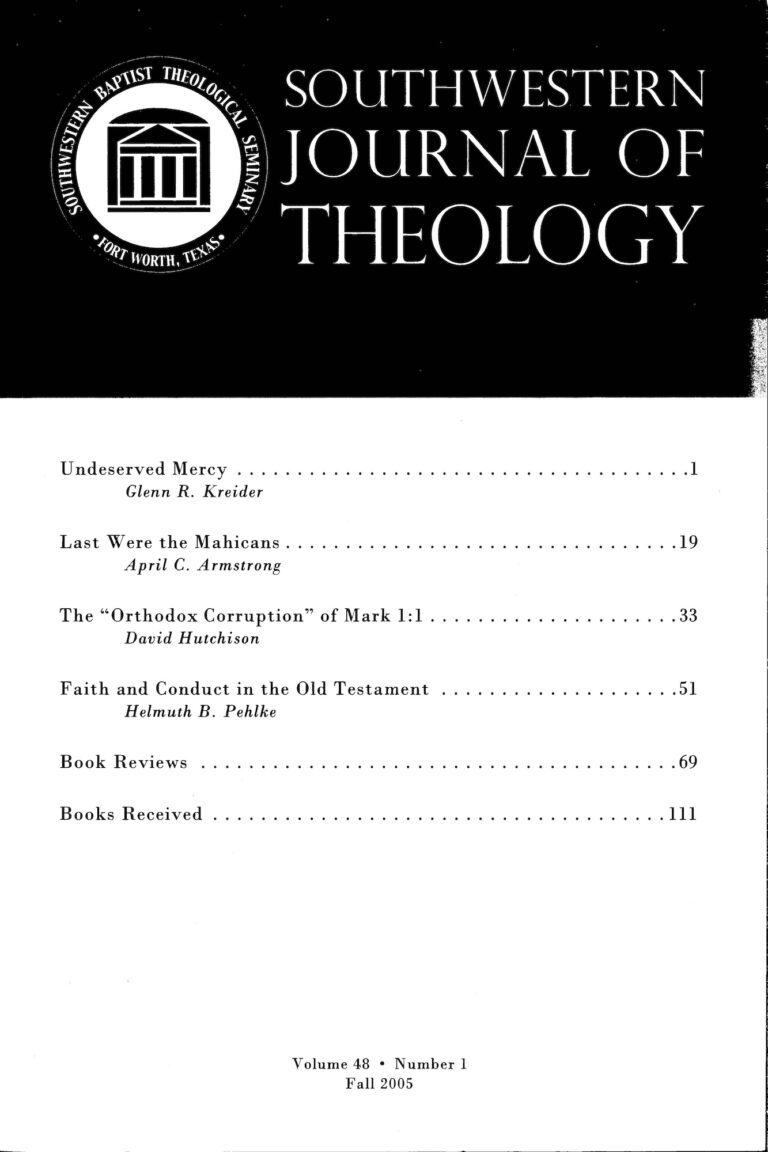
Southwestern Journal of Theology (48.1)
Southwestern Journal of Theology
Volume 48, No. 1 - Fall 2005
Editor: Paige Patterson
Edited by Sheila E. McGinn. Grand Rapids: Eerdmans, 2004. 276 pages. Hardcover, $36.00.
This Festschrift volume honors Robert Jewett and his lifelong interest in Romans. Four former students of Jewett and one colleague solicited and compiled fourteen essays under five different approaches—theological, rhetorical, social-historical, feminist, and an approach titled “a dialogue with contemporary life.”
From a theological approach, James D. G. Dunn addresses the issue of “covenant theology” in Rom. 9:4 and 11:27 and argues that Paul does not take over the categories of Israel’s covenant and apply them to Christians. Rather, Paul affirms Israel’s covenant in a manner that Israel could recognize. Jeffrey B. Gibson looks at the theological significance of Paul’s use of the dying formula (X died/gave himself for Y) in secular works and non-Pauline New Testament letters to find that Paul was engaged in a profound polemic against the prevailing values of his day concerning public salvation—Christ did not seek glory, nor advocate war, and instead of dying for his own, he died for his enemies. Graydon F. Snyder discusses sixteen theological motifs that derived from the reading and study of Romans.
From a rhetorical approach, William S. Campbell points out the strong links between chapter 8 and chapters 9-11 concerning Jewish and Christian identity finding that the groups of Jewish and Gentile believers were distinguished by their differing lifestyles and that there was no inclusive term used to describe all believers. James Hester investigates the rhetorical aspect of Paul’s persona proposing that Paul creates an audience to convince the Romans that he and they shared common values. Wilhelm Wuellner applies the theory of argumentation and the theory of intentionality to Romans.
From a social-historical approach, Peter Lampe pieces together different sources to show that one of the ways Christianity came to the Roman synagogues in the 40s of the first century was through Roman households—through their Jewish servi and liberti and their descendente. Carolyn Osiek looks at the lifestyle of the second-century Christian community in Rome and suggests that Roman Christians had a degree of cultural and ethnic diversity unparalleled in other Christian networks throughout the empire.
From a feminist hermeneutic, Sheila E. McGinn offers the reading of αδελφοί as inclusive (“brothers” and “sisters”) suggesting the possible interpretation that women and men are to take on the priestly role by offering themselves entirely to God (12:1). Elsa Tamez interprets justification in Romans 1-8 as Paul proclaiming a new humanity. Pamela Thimmes reviews the literature on Paul’s use of marriage and adultery in Rom. 7:1-4 and explores how women in the Roman community might have understood Paul’s meaning.
In a creative conversation with Paul’s letter and contemporary life, Keith Burton compares similarities of audience and themes of Romans with the 1991 film “Regarding Henry,” and L. D. Hurst extends a dialogue between Romans and two American films, George Steven’s “Shane” (1952) and Clint Eastwood’s “Pale Rider” (1984). Reta Halte-man Finger offers helpful classroom aids and simulation exercises to facilitate an understanding of Roman house church dynamics.
These essays, with their diverse approaches, challenge both student and scholar. The authors raise interesting interpretive questions and advance current interpretive trends.





